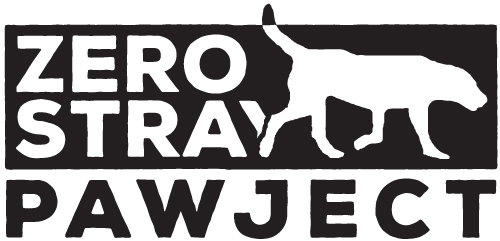Our Mission
Zero Stray Pawject's mission is to systematically eradicate the problem of stray dogs and cats by addressing the root causes through prevention. Our programs aim to intervene BEFORE a pet ends up on the street, rather than treating the symptoms AFTER a pet is already on the street.
To achieve our mission, we collaborate with national and local governments and design programs that combat these root causes through focusing on responsible pet ownership. We access the situation, design targeted pet homeless prevention initiatives, help local governments to execute and measure its impact with clearly defined KPIs. Through engaging with all relevant stakeholders in a community we drive sustainable behavior change that is long term oriented.
We are not reliant on public funding, we are exclusively financed by private donations.
* Treatment is not cure, but rather treating a symptom. Treatment is expensive, time consuming and resource limited. It can’t solve the problem on its own.
Our work:
We work on 3 levels:
we are outcome driven
We are outcome orientated and ensure we have the right metrics and KPIs in place to track the success of our pet homelessness prevention programs.
By Greek Law, municipalities are responsible for stray animals. However, many lack the resources and know-how to solve the problem. This is where Zero Stray Pawject and Zero Stray Academy come in to educate and afterwards help municipalities, the police and the judicial in a hands-on approach to implement changes to improve communities.
Stray dogs and cats are a direct or indirect consequence of irresponsible pet ownership. The solution of stray pets come from an effort to create responsible and accountable owners and drive sustainable behavior change that results in long term success.
The Problem today
Today's problem
Owned dogs and cats are generally not neutered, roam and produce an overpopulation of dogs and cats. Some irresponsible owners abandon their dogs and cats on the street. Abandoned dogs and cats are usually not neutered/spayed which has a multiplicative effect on stray populations.
The Pawject
No shelter will ever be big enough to accommodate every stray dog and cat, and there will never be enough families to adopt. We need to tackle the root-cause of irresponsible ownership
Stray Prevention Programs
Reduce the likelihood of a dog and cat ending up on the street through a multiple stakeholder approach, one community at a time.
Municipality
Key action: (1) Promote micro-chipping and registration so that owned pets are identifiable if lost or abandoned. We are providing the tools to municipalities to be successful and in this context set up enhanced pet registries. We educate local governments to implement innovative ways of how to get owners to microchip their pet, partly by allowing for low cost microchipping and registering, and other incentives to drive behavior change (2) We promote and subsidize targeted pet-owner level neutering campaigns addressing each owner’s individual concern on a large scale basis, to avoid unwanted litters.
(3) We also set up the world’s first academy to train municipalities how to reduce the number of strays systematically and sustainably. For more information, visit our separate organization Zero Stray Academy.
Police
Key action: Educate how to enforce law against owners who (a) abandon their pets, (b) don’t micro-chip their pets, (c) abuse their pets. ZSP has donated microchip scanners to the Hellenic Police, Forest Police and Coast Guards in regions where we are active. We educate police officers on animal welfare matters. Aegina was the first region across Greece that started owner controls since 2019.
Schools
Key Action: 1.) Educate the next generation on responsible pet ownership; render them animal welfare ambassadors inside their families. ZSP partners with the right local organizations to educate children and teenagers in local schools and liaises with the municipalities. Children are our future. 2.) We provide innovative ways to educate pet owners regionwide on responsible pet ownership. For example, in partnership with municipalities and municipal water authorities, we send education brochures in the waterbill; we send text messages through the municipality to pet owners and train the municipality how to make calls to pet owners to promote responsible dog ownership.
Local outreach
We collaborate with local partners to run stray pet census studies to understand the size of the issue and plan actions accordingly.
Starting in 2023, we will start running stray dog and cat neutering programs systematically and sustainably by collaborating with local volunteers, local vets and experts across Greece to appropriately capture stray dogs and cats in a humane, non cruel way. This reduces the number of stray dogs and cats born on the street.
In certain instances, we may get involved and revamp private or municipal shelters, such as we have done in Mykonos in 2016 and in Sparta in 2022.
We have supported in the past, and may support in the future local non-kill animal welfare organizations to enable them to take stray pets off the street before they get injured or reproduce. In such a case, local animal welfare organizations must comply to the “Bill or Rights” that defines living conditions and other rights. We also helped with non-adoptable-dogs getting adopted into the right homes in the past.
We are planning more local outreach programs in the future. Best to follow us on Facebook or Instagram to stay up-to-date.
The Pawject is a unique systematic solution to educate and by that, empower local governments to combat the crisis on their doorstep.
Zero Stray Pawject gets involved where valiant efforts by local governments and local animal welfare have failed to eradicate the stray animal problem and partners with local governments to support them.
The Result
Our work promotes animal welfare and protects the communities we serve from an uncontrolled stray pet population that can pose public safety and public health risks.









